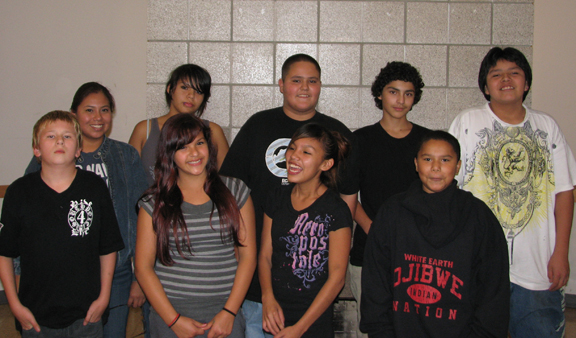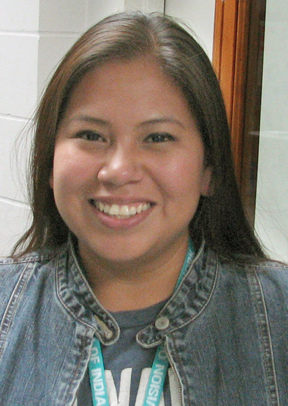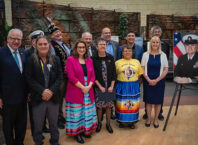 American Indian youth are challenging their community to take a stand against commercial tobacco. The students, ages thirteen to seventeen, are working hard to educate Native businesses and agencies in the Twin Cities about eliminating commercial tobacco from their workplaces.
American Indian youth are challenging their community to take a stand against commercial tobacco. The students, ages thirteen to seventeen, are working hard to educate Native businesses and agencies in the Twin Cities about eliminating commercial tobacco from their workplaces.
The students are part of the Mashkiki Ogichidaag program, which is supported by the Division of Indian Work. The program seeks to educate students about the adverse effects of commercial tobacco abuse, as well as teach Native youth about tobacco’s traditional uses in Native American culture.
"The program is named Mashkiki Ogichidaag, which translates into ‘Medicine Warriors’," said Leya Hale, the program coordinator of Mashkiki Ogichidaag. Hale stepped into the role of coordinator in March 2011. "This program has been around for about three years. The Division of Indian Work hires grant writers to apply for the funding that makes programs such as these possible," said Hale.
The Division of Indian Work, founded in 1952, is the oldest organization directly serving American Indians in the Twin Cities area. Located at 1001 East Lake Street, the Medicine Warriors hold their meetings in a room upstairs next to the kitchen. There is macaroni and cheese with a make-it-yourself-chili dog table for the youth. Hale says she always tries to provide for students who are taking time out of their day to listen to her words. Sitting in their chairs, arranged in a circle, the students talk about the traditional uses of tobacco.
 "I learned that there are two different types of tobacco; traditional and commercial," said Ulysses Strong, a student originally from Bois Forte. The other members of the group explain how tobacco is used in Native traditions for prayers, gift giving, blessings and medicinal purposes.
"I learned that there are two different types of tobacco; traditional and commercial," said Ulysses Strong, a student originally from Bois Forte. The other members of the group explain how tobacco is used in Native traditions for prayers, gift giving, blessings and medicinal purposes.
"There are really bad things that happen if you smoke or chew or use tobacco in ways that aren’t traditional," said Ivan Mekeithan, a Kiowa and Ojibwe youth. The students go into detail describing the long term health effects of commercial tobacco. They describe how cigarettes can have thousands of chemicals in them, such as ammonia and formaldehyde. They also talk about how traditional tobacco is different from commercial tobacco.
"I learned how many medicines come from the earth; and that traditional tobacco is one of those reserved for Natives. People always take from the earth, but they never give. That’s why Natives offer tobacco back to the earth, I think," said Jaden Bruener, an Ojibwe student from White Earth.
The students use the knowledge they receive from their discussions to encourage change in their communities. One way in which they do this is by going to American Indian workplaces and presenting the health risks associated with commercial tobacco use.
One of the most effective ways to communicate their message of anti-commercial tobacco usage in the Native community is through the use of media.
"I have a media background, so one thing I like to do is provide the students with some media software training," said Hale. "We create public service announcements. We go out into the community and show them both what the students are learning and also have the students teach others about the dangers of smoking commercial tobacco. Using the power of media tools such as Powerpoint or DVD’s, we try to send a clear message to the businesses and agencies we visit: commercial tobacco use needs to stop in our community."
The majority of the students in the program are either in middle school or are early freshman in high school. "We’re trying to educate them as early as we can about the harmful effects of smoking, about the dangers of commercial tobacco use. But at the same time, we are traditional tobacco advocates," said Hale.
"I love working with the kids; I provide them with some of my knowledge in video production, and they in turn teach me about themselves. It doesn’t matter what setting I find myself in; I love giving back to the community I serve and I hope that I’m passing on some of the useful skills I learned in life to our next generation of youth. Media is such an important part of our lives these days. I think training these students to get the message about smoking across is invaluable," said Hale.
The students themselves are enthusiastic about working to make a difference in their communities. One of their projects, a compilation DVD that showcases video shorts the students produced for the program, has clips with titles such as, "What would you rather be doing?" and "Secondhand smoke at work". The clips intersperse facts about the harms of commercial tobacco use with students acting out skits or simply talking about what they would rather do besides smoke. The positive attitude and upbeat message of the students in the program is what Hale hopes will begin to make others in the community take notice.
"To help our community become healthy, I believe it is important that this information about the harmful effects of commercial tobacco is coming from our young people. It’s not often you hear youth speaking up about the dangers of smoking. Oftentimes you will see these anti-smoking campaigns where it is adults teaching students. But in our program it is students teaching adults, and I think that’s something special," Hale said.
Many of the students involved in the program are at-risk when it comes to tobacco in the household. Hale believes this is why it is all the more meaningful these students participate in the program.
"All of the students I work with are very intelligent; they are at-risk youth who are working to promote tobacco-free schools and homes. There are many kids who think that their voice may not matter; that they have to listen to or follow the examples of their older peers. But what these students are doing is showing that if they speak up their voices will be heard," said Hale.
There are other initiatives the group has participated in . Cleaning up cigarette butts around the American Indian Center was one such activity. Collecting all the cigarette butts and placing them into one extra large, see-through plastic bag, the message they hope to send to Native agencies is clear – "Please don’t smoke outside because we all share the same air."
Hale is proud of her student’s work, and is happy to assist them in their next efforts to stop commercial smoking in the Native community. "Our group is unique because most tobacco prevention groups simply teach them ‘don’t smoke.’ But what we’re doing is taking it a step further by taking action and reaching out to our community. By encouraging the adoption of policies that limit the presence of commercial tobacco in our neighborhoods we’re both teaching and learning at the same time," Hale said.
The Mashkiki Ogichidaag program is funded by grants and was started through the Minnesota Department of Health. If you are interested in learning more about the program or would like your children to participate, contact Leya Hale at lhale@diw-mn.org, or stop by the Division of Indian Work, 1001 East Lake Street in Minneapolis.






